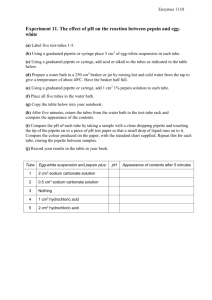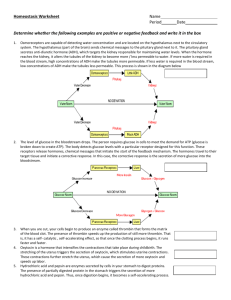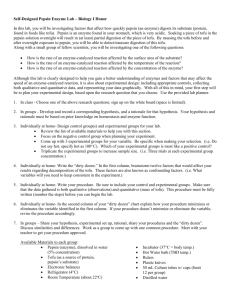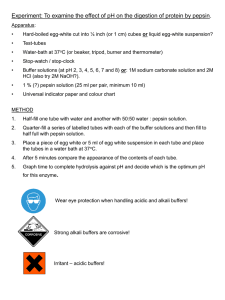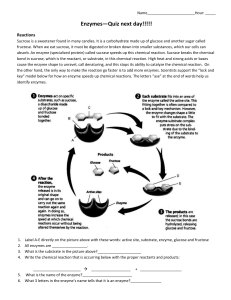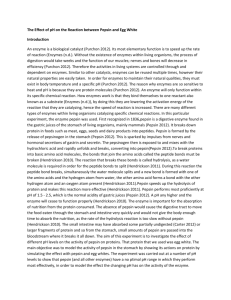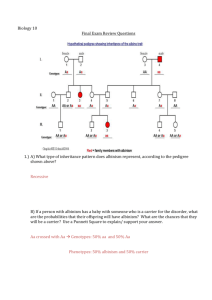Experiment 4
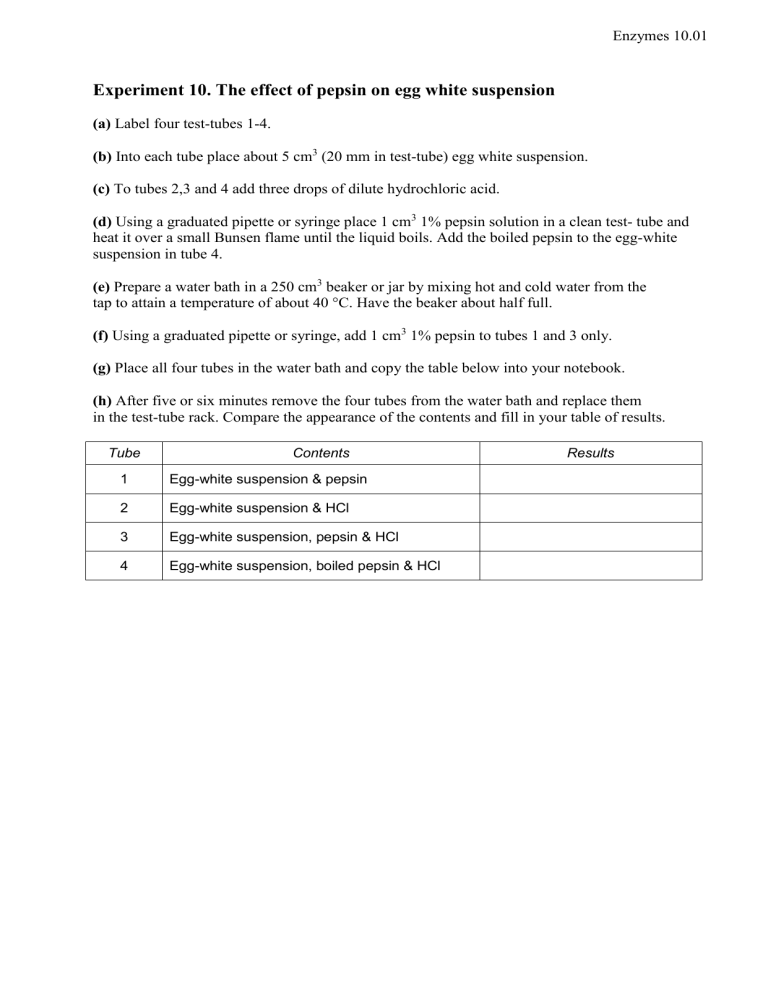
Enzymes 10.01
Experiment 10. The effect of pepsin on egg white suspension
(a) Label four test-tubes 1-4.
(b) Into each tube place about 5 cm
3
(20 mm in test-tube) egg white suspension.
(c) To tubes 2,3 and 4 add three drops of dilute hydrochloric acid.
(d) Using a graduated pipette or syringe place 1 cm
3
1% pepsin solution in a clean test- tube and heat it over a small Bunsen flame until the liquid boils. Add the boiled pepsin to the egg-white suspension in tube 4.
(e) Prepare a water bath in a 250 cm
3
beaker or jar by mixing hot and cold water from the tap to attain a temperature of about 40 °C. Have the beaker about half full.
(f) Using a graduated pipette or syringe, add 1 cm
3
1% pepsin to tubes 1 and 3 only.
(g) Place all four tubes in the water bath and copy the table below into your notebook.
(h) After five or six minutes remove the four tubes from the water bath and replace them in the test-tube rack. Compare the appearance of the contents and fill in your table of results.
Tube Contents Results
1 Egg-white suspension & pepsin
2 Egg-white suspension & HCl
3 Egg-white suspension, pepsin & HCl
4 Egg-white suspension, boiled pepsin & HCl
Enzymes 10.02
Experiment 10. Discussion
1 Why, do you suppose, does the egg white suspension used in the experiment look cloudy?
2 If the egg-white suspension goes from cloudy to clear, what change must have occurred?
3 In which of the test-tubes are the conditions most like those in the stomach?
4 In general, how is an enzyme affected by boiling?
5 Do the results with tubes 3 and 4 prove that pepsin is an enzyme?
6 Are the results with tubes 3 and 4 consistent with the theory that pepsin is an enzyme that can accelerate the digestion of egg-white?
7 Are the results consistent with the theory that pepsin is an enzyme which, in acid conditions, can digest proteins? .
8 Suppose the hypothesis is advanced that hydrochloric acid is an enzyme but can digest egg-white only in the presence of unboiled pepsin, what control experiment would help to eliminate this explanation? add 1cm 3 pepsin
to tubes 1 and 3
5 cm 3 egg-white suspension approx 40°C
Place 3 drops hydrochloric acid in tubes 2-4 boiled pepsin
Enzymes 10.03
Experiment 10. The effect of pepsin on egg-white suspension - preparation
Outline In the presence of hydrochloric acid, pepsin turns a cloudy suspension of egg-white into a clear solution. Controls are conducted with hydrochloric acid by itself, pepsin by itself and boiled pepsin with hydrochloric acid.
Prior knowledge The interpretation of results will be easier if the student knows already that egg-white suspension consists of solid particles of albumen, suspended in water; enzymes are inactivated by boiling, conditions in the stomach are acid.
Advance preparation and materials per group
1% egg-white suspension * 25 cm hydrochloric acid
1% pepsin solution 10 cm3 (bench strength, e.g. 10% or 2M) 5 cm
3
Apparatus per group test-tube rack and 5 test-tubes 250 cm
3 beaker
4 labels or spirit marker thermometer
Bunsen burner dropping pipette test-tube holder graduated pipette or syringe (1 - 5 cm
3
)
* See Reagents for food tests and enzymes p. 01
Experiment 10. Discussion - answers
1 The cloudy appearance of egg-white suspension is due to solid particles of albumen suspended in water.
2 The clear liquid is now a solution and the solid particles must have dissolved.
3 Tube 3 approximates to the conditions in the stomach having pepsin, hydrochloric acid and a temperature between 35 °C and 40 °C.
4 Enzymes, being proteins, are denatured above 45-50 °C, i.e. enzyme activity is destroyed by boiling.
5 The results in tubes 3 and 4 do not prove pepsin to be an enzyme. It could be that hydrochloric acid hydrolyses egg-white (just as it hydrolysed starch in experiment 8) but will only do so if unboiled pepsin is present.
6 The results in tubes 3 and 4 are certainly consistent with the hypothesis that pepsin is an enzyme. This hypothesis would account for the fact that the egg white was not dissolved by boiled pepsin.
7 Egg albumen is a protein and the results suggest that pepsin can digest it, but it is not possible to make a generalization which includes all proteins on the basis of an experiment with one of them.
8 The control would be to repeat the experiment with tube 3 but using boiled hydrochloric acid.
If the egg-white suspension does not go clear, it looks as if hydrochloric acid has properties analogous to an enzyme. (To students with any knowledge of the definition of an enzyme and the structure of proteins and of hydrochloric acid, the hypothesis is patently untenable.)
